
© Anne Van Aerschot. (Click image for larger version)
Rosas & Ictus – Anne Teresa De Keersmaeker
Vortex Temporum
London, Sadler’s Wells
7 May 2014
www.rosas.be
www.sadlerswells.com
It would be usual and appropriate to regard this performance of Vortex Temporum as the UK premiere of a work created last year by the avant garde Belgian choreographer, Anne Teresa De Keersmaeker, and first performed as part of the Ruhrtriennale festival, held in October. But, I prefer to think of it as an artistic enhancement of the music of the same name, one of the last compositions of the late Gérard Grisey, completed just two years before his early death (aged 52, in 1998). Although separated by 17 years, it seems as if this creative mix has been a continuous process, a relay in which the baton has been handed from composer to choreographer in a seamless collaboration. Merce Cunningham and John Cage often worked together by not co-operating; and it seems that De Keersmaeker and Grisey have followed suit, even if – in the composer’s case – it is a collaboration that began beyond the grave.
In so many ways De Keersmaeker’s interpretation remains faithful to the simple structural form of a musical concert, albeit one where the seven musicians of Ictus are joined onstage by the same number of dancers from Rosas. The gunmetal grey walls that surround three sides of the Sadler’s Wells stage are laid bare, containing just a piano and a few chairs, embellished only by strange tribal patterns of spiral markings on the floor.
We might normally associate the word “vortex” with turbulent activity (a cyclone or a whirlpool are examples of this spinning mass of vortical flow) although the choreographer is on record as defining the title simply as the “spiral of time”. Her interpretation would appear more accurately to describe the gentle minimalism of Grisey’s score, which is often labelled by the genre known as “spectral music”, although this was a term disavowed by the composer by the time of Vortex Temporum.
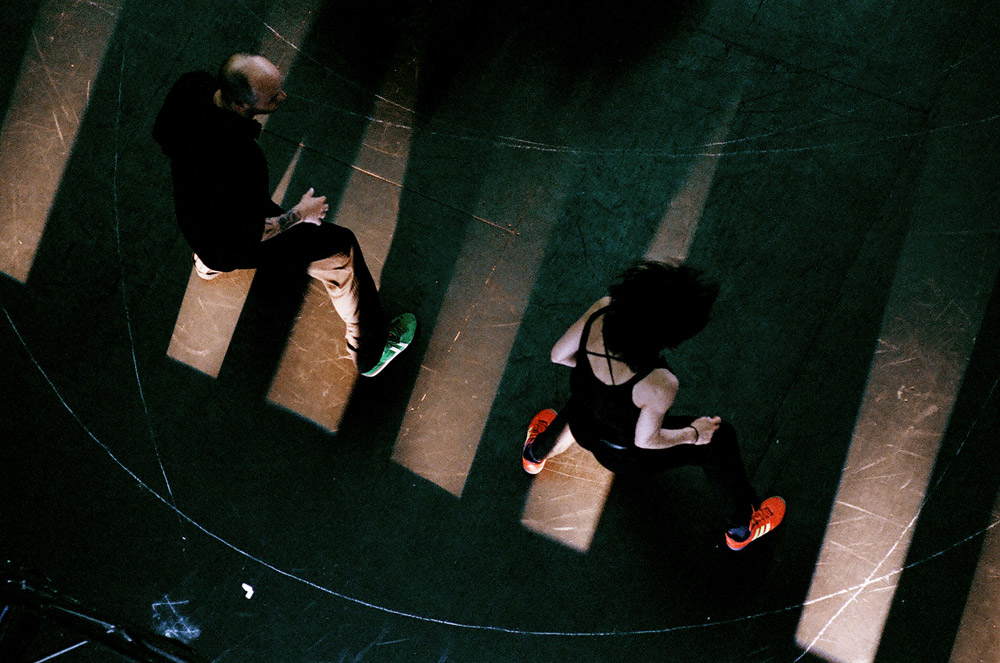
© Anne Van Aerschot. (Click image for larger version)
Thus it would appear that the fundamental point of this production is that the bodies playing the piano, clarinets, flutes, violin, viola and cello combine with an equal number of bodies that interpret their sounds in movement. In the first two sequences this relationship is played out in relay. The initial septet to take the stage are the musicians, energetically playing the first of three sections, which itself is divided into three parts, concluding with a virtuoso piano solo. This last contribution ends abruptly when the charismatic pianist (Jean-Luc Plouvier) slams down the final chord before jumping from his stool to take a long, circuitous walk offstage, once more reinforcing the overwhelming theme of swirling sound and motion.
Amongst the current crop of viral images doing the rounds on social media is a photograph of birds on telephone wires, configured like a musical stave, which a man called Jarbas Agnelli turned into an award-winning musical composition simply by plotting notes against the position of the birds. Grisey’s music appears to have a metaphorical alignment to the tonal quality of similar patterns of activity within the natural environment. And so, throughout this musical opening I was struck by the image of waves, rippling outwards in a pond that has been disturbed by the intervention of a stone, the varying vibrations of a butterfly’s wings, or the reverberating force of a reed buffeted in the wind.
Once Plouvier, the pianist, had walked, following a brief interlude of silence, the dancers arrive, performing to a soundscape of their own breathing, punctuated by the regular squeaks of their ubiquitous trainers. But there is no doubt that they are reprising the sounds of Grisey’s first section in their spiralling actions, which play with issues of balance and verticality. Even though the musicians and the music have temporarily disappeared, it is nonetheless, literally, Grisey’s first movement. In the same way that aspects of his music play upon simple waves of rotational chords and descending scales, utilising variable intervals and rhythms, so the choreography devised by De Keersmaeker – and developed by her dancers – employs a small group of simple motifs, restructured to fit differing time patterns. Both the spatial organisation of the choreography and the simple articulation of basic drivers of human movement are cleverly aligned to music that we can no longer hear.
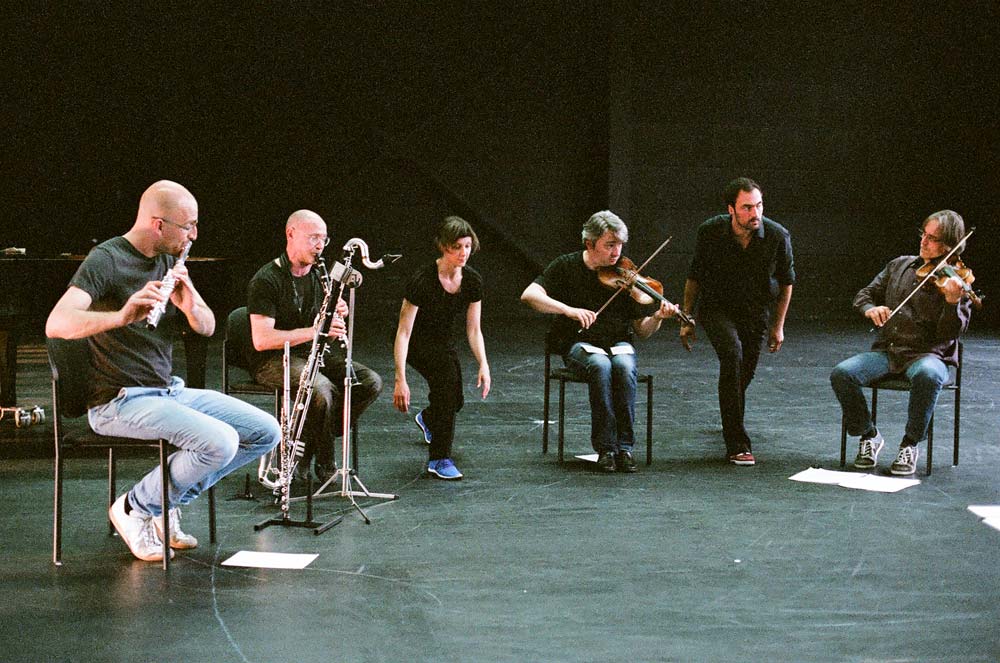
© Anne Van Aerschot. (Click image for larger version)
The middle part seems to reflect the opening section but generally in a much slower tempo that therefore requires an expanded structure (and more time). Here the musicians and dancers mingle with the latter’s movement interleaved as if a twine threaded through the musical stave. There is little physical connection between the two sets of performers although one of the dancers forcibly replaces Plouvier at the piano stool for a short while (it may be coincidental but pianist and dancer have a passing physical resemblance, both bearing closely-shaven heads).
Even though the concept of music and movement interacting as one combined entity is now piecing together, paradoxically it is also where the work begins to come off the rails, at least in my mind. The long process of reiteration and interpolation reaches its zenith in the third part: expanding the same sounds and movements into longer and longer time sequences, which extends the academic rigour beyond the point of fascination so that it becomes a test of endurance. Confusion and tiredness creep into one’s consciousness and I began to question the simple statements that I had taken for granted in those absorbing two takes on the first section.
Vortex Temporum is hard core contemporary culture both in choreography and music, more concerned with the analytical appreciation of geometry, horology, musical structure and theory than it is about entertainment. In a strange and unique way I felt both enriched and enfeebled by the experience. Even though the whole event lasted barely an hour, it exhausted me. I felt debilitated, as if I had been fighting a mental battle against a tag-team of two creative colossi. And while I may have successfully held my own for the first two rounds, I’d been soundly beaten by the end.












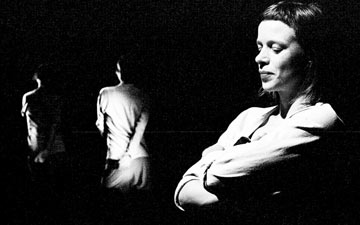


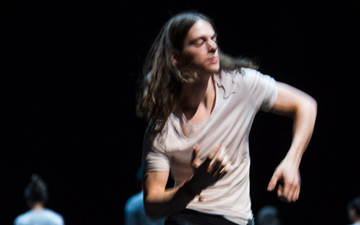
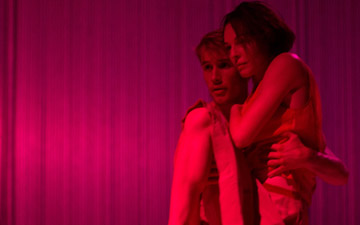
You must be logged in to post a comment.